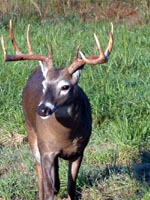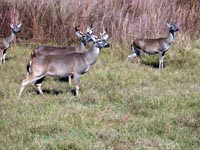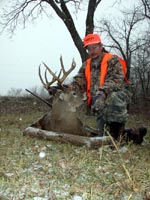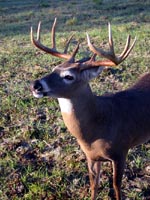
|
Features
|
|
|
|
Books
|
|
|
|
Fun & Games
|
|
|
|
Contact Us
|
|
|
John's Journal... Entry 123, Day 1
THE KEY TO HOLIDAY BUCKS
Best Characteristics for a Holiday Hunting Spot
 EDITOR'S
NOTE: Christmas and New Year's Day, times for family gatherings across
the nation, are also times of high hunting pressure in areas where hunting
season is still in, as it is in parts of the South. There families will
assemble and hunt together according to southern tradition. This week
we'll take a look at what hunters need to do to have the most-productive
opportunities while hunting during the holidays.
EDITOR'S
NOTE: Christmas and New Year's Day, times for family gatherings across
the nation, are also times of high hunting pressure in areas where hunting
season is still in, as it is in parts of the South. There families will
assemble and hunt together according to southern tradition. This week
we'll take a look at what hunters need to do to have the most-productive
opportunities while hunting during the holidays.
The three bucks I saw of Rick Nelms several years ago were three of the finest deer I ever had seen taken by one man in a lifetime -- much less in one season. All three deer, which were bagged in Alabama, weighed over 200-pounds each and were bagged during the Christmas student break. During this same 30-day period, Nelms harvested several other bucks.
 Scouting
before deer season is important to a hunter's success afield, and scouting
before the holidays is truly critical to taking holiday deer. Nelms, who
was working on his master's degree in forestry in Mississippi when he
took the huge bucks, had spent many hours in the woods looking for deer
and studying deer habitat. From his research, he had pinpointed big-buck
holiday hotspots.
Scouting
before deer season is important to a hunter's success afield, and scouting
before the holidays is truly critical to taking holiday deer. Nelms, who
was working on his master's degree in forestry in Mississippi when he
took the huge bucks, had spent many hours in the woods looking for deer
and studying deer habitat. From his research, he had pinpointed big-buck
holiday hotspots.
"I have certain criteria I look for in an area before I climb into a tree to spend the day," Nelms says. "First, I want to find a spot to hunt that will be at least a mile away from any place I think another hunter ever may be. I want to get as far back in the woods as I can -- away from roads and other access points. I'll search for a clear-cut, a briar thicket, a honeysuckle thicket or some other type of heavy cover to hunt beside. I prefer having water, like flooded timber, some kind of slough off a main river system, a creek or a ditch next to the thicket. But the water must be 20- to 50-yards wide. Finally, on the edge of that water, I look for either a feeding area before the rut or a hot scrape during the rut."
 Nelms
has specific, sound, logical reasons why he must have this kind of habitat
and terrain in which to hunt trophy holiday bucks. "I want to be
at least a mile away from all the other hunters, because that less-hunted
region will be where the big bucks will be," Nelms explains. "Occasionally
you'll find bucks in places with lots of hunting pressure. However, probably
the deer just have happened to be there or have gotten caught there, but
they don't intend to be in that area. The bigger, older bucks will retreat
from intense hunting pressure. Another reason I like to locate a place
to hunt at least a mile to two miles away from any other hunter is because
the bucks you discover in these regions usually will be easier to pattern,
since they don't experience much hunting pressure. Too, they're more likely
to follow the same routine day in and day out."
Nelms
has specific, sound, logical reasons why he must have this kind of habitat
and terrain in which to hunt trophy holiday bucks. "I want to be
at least a mile away from all the other hunters, because that less-hunted
region will be where the big bucks will be," Nelms explains. "Occasionally
you'll find bucks in places with lots of hunting pressure. However, probably
the deer just have happened to be there or have gotten caught there, but
they don't intend to be in that area. The bigger, older bucks will retreat
from intense hunting pressure. Another reason I like to locate a place
to hunt at least a mile to two miles away from any other hunter is because
the bucks you discover in these regions usually will be easier to pattern,
since they don't experience much hunting pressure. Too, they're more likely
to follow the same routine day in and day out."
Locating thick cover is an essential part of the Nelms' game plan. He's found that deer generally bed and hole up in thick cover as well as use it as a home base. "Thickets are where the bucks prefer to be," Nelms explains. "If you watch deer very much, and I have, you will notice you will see more deer moving in and out of heavy cover than you will in any other section of the woods. I want to have water close to or adjacent to that cover, because I believe the smart bucks have learned that water provides sanctuary. Deer know that usually hunters won't cross water to find them. Too, a dog will lose a deer's track if the deer fords water. The deer's ability to spot and hear danger is easier across water. My personal belief is that deer utilize water as a barrier, much like the knights of old used water in moats to protect them while in their castles.
 "Another
advantage of having water adjacent to my stand is it provides a quiet
path to and from my stand. When I travel to my stand before daylight,
I wade the water, leaving no scent and making little if any noise. Even
if the deer does hear me in the water, it probably assumes I'm a beaver,
a duck or some other kind of water critter. Yet another reason I like
water near my hunting thicket is because it enables me to hear a deer
coming. If you're accustomed to listening to deer moving in water, then
hearing them is easy. When I take a stand, I put the water to my back,
because generally I can hear a buck in the water before I ever see him.
If the deer is coming out of a bedding area into a feeding region, I'll
be able to hear him in plenty of time to stand up and take a shot as he
crosses the water.
"Another
advantage of having water adjacent to my stand is it provides a quiet
path to and from my stand. When I travel to my stand before daylight,
I wade the water, leaving no scent and making little if any noise. Even
if the deer does hear me in the water, it probably assumes I'm a beaver,
a duck or some other kind of water critter. Yet another reason I like
water near my hunting thicket is because it enables me to hear a deer
coming. If you're accustomed to listening to deer moving in water, then
hearing them is easy. When I take a stand, I put the water to my back,
because generally I can hear a buck in the water before I ever see him.
If the deer is coming out of a bedding area into a feeding region, I'll
be able to hear him in plenty of time to stand up and take a shot as he
crosses the water.
"The next critical factor to my successful hunting
is for me to locate a feeding area beside the water. I'll search for an
acorn flat full, hopefully, of overcup acorns, white oak acorns and/or
water oak acorns. Then I have an ideal setup. The deer will move out of
their bedding area, cross the water and feed on the acorns. Or, they'll
be coming to their bedding region, while munching some acorns and crossing
the water on the way. When I find a place like this, I can hunt deer coming
and going from their daily activities. Sometimes I'll take a stand close
to the bedding area early in the morning because with hunting pressure
high, most of the deer will be feeding at night and bedding at first light.
"However, when deer are in the rut, I won't be as concerned about
discovering a food source. Instead of searching for food regions along
the edges of water, I'll be looking for scraping areas. During the rut,
I need to be set up close to a scrape and between the scrape and the water."
To learn more about how master deer hunters bag their deer each year, go to www.nighthawkpublications.com's home page, and click on books. To order with a credit card, call (800) 627-4295. You'll find information for ordering with a check or money order at the site.
TOMORROW: FINDING THE RIGHT HOLIDAY PLACE TO HUNT
Check back each day this week for more about holiday bucks...
Day 1 - Best Characteristics
for a Holiday Hunting Spot
Day 2 - Finding the Right Holiday Place to
Hunt
Day 3 - Making a Silent Approach
Day 4 - When and Where to Take the Shot
Day 5 - Take Care of Your Hunting Hotspot